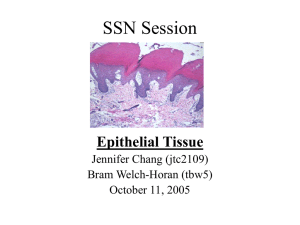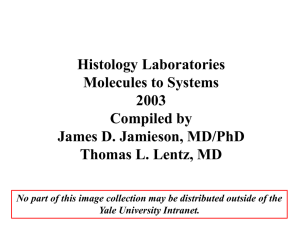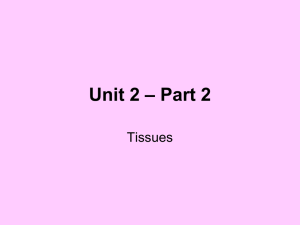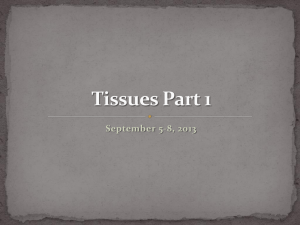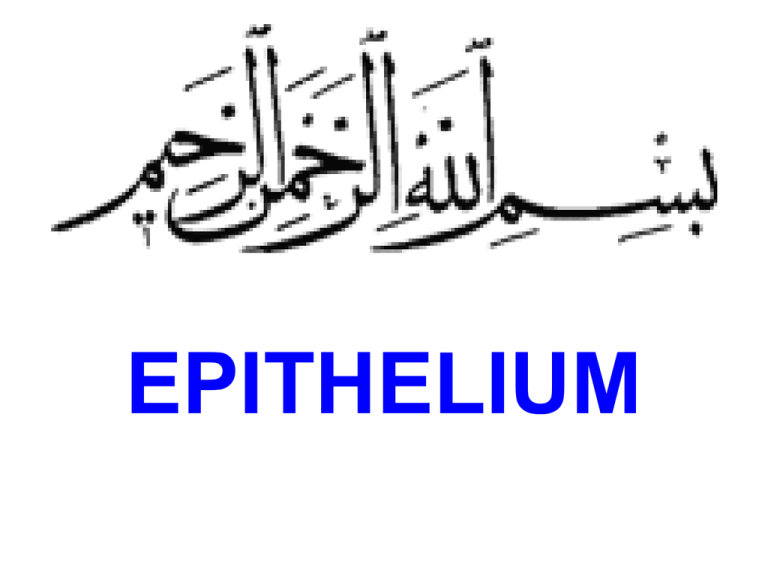
EPITHELIUM
•
•
•
•
What is meant by epithelium?
Define epithelium
Why epithelium is called epithelium
Why epithelium is given this name
•
Following statements regarding epithelium are
correct except
A. Epithelium is layered collection of cells covering
external and internal surfaces of the body,
including the lining of vessels and other small and
large cavities.
B. The term, epithelium was used to refer to the
cellular covering of the nipple.
C. Epithelium is predominantly cellular tissue with
numerous intercellular junctions
D. Epithelium is a layered collection of cells with
large amount of intercellular material.
E. The main function of the epithelial lining of gastrointestinal tract is absorption.
• Epithelium, pl. epithelia.
[Gr. epi- on + Gr. thēlē nipple]
• Epithelium is layered collection of cells
covering external and internal surfaces of
the body, including the lining of vessels
and other small and large cavities.
• This term (epithelium) was used to refer to
the cellular covering of the nipple.
• Nipple is also called thelium.
• Thelium is a papilla or a nipple.
• Later on the term epithelium has been
extended to include the cellular coverings
of the external and internal surfaces of the
body.
• The term epithelium derives from the fact
that the interface between epithelium and
the underlying connective tissue frequently
shows projections and depressions
(epidermal and dermal papillae) which
appear as small nipples.
• Epithelium is predominantly cellular tissue
with numerous intercellular junctions and
very little intercellular substance.
• Epithelium is a layered collection of cells,
held together in close contact by
intercellular junctions, with a small amount
of intercellular material.
Epithelium palm of hand. H&E 400x.
Epithelium of Esophagus. H&E 100x.
Eithelium lining Trachea. H&E 400x.
Epithelium in Urinary bladder. H&E 400x.
• Epithelium is the covering of internal and
external surfaces of the body, including the
lining of vessels and other small and large
cavities.
• Simple Squamous Epithelium lining a
Capillary wall.
• H&E stain. Magnification 400x.
• What are the functions of epithelium
• Functions of epithelial tissue are
protection,
secretion,
absorption and
sensation.
• How the epithelium is separated from
the underlying connective tissue
• ALLAH THE KHALLAQ-UL-ALLEEM خالق
العليمhas placed a membrane between the
epithelium and connective tissue called
basement membrane.
• Name the components of basement
membrane
• This membrane consists of two
components, basal lamina derived from
epithelium and reticular lamina derived
from connective tissue.
• Describe the blood supply of
epithelium
• How the epithelium is gets its nutrition
• Epithelium is avascular.
• Nutritive materials and oxygen enter it by
diffusion through the cells and across
basal lamina.
Classification of Epithelium
• There are two types of epithelial tissue:
–Surface Epithelium
–Glandular Epithelium
SURFACE EPITHELIUM
• The epithelium covering the body or lining
the surfaces of body cavities, viscera and
tubes or hollow channels in the body is
called surface epithelium.
• It is divided into two main varieties.
•
•
Classical: Here the cells forming the
epithelium are arranged in regular layers.
It may be single layered or many layered.
Non-Classical: This type of epithelium
contains single layered as well as many
layered cells. They are not regular in
arrangement.
• Classical Epithelium
• Unilayered epithelium
–Simple squamous
–Simple cuboidal
–Simple columnar
• Classical Epithelium
• Multilayered epithelium
–Stratified squamous
–Stratified cuboidal
–Stratified columnar
• Non-Classical epithelium
• Complex Epithelium
–Pseudostratified epithelium
–Transitional epithelium
–Seminiferous epithelium
• Non-Classical epithelium
• Specialized Sensory Epithelium
–Olfactory epithelium
–Gustatory epithelium
–Auditory epithelium
–Retinal epithelium
Simple Squamous Epithelium
• Simple squamous epithelium
consists of a single layer of flat
cells that resemble the tiles on a
floor.
• The nucleus of each cell is
centrally placed and is rounded or
oval.
• Simple Squamous Epithelium lining a
Capillary wall.
• H&E stain. Magnification 400x.
• The lining of all blood vessels is simple
squamous epithelium, and usually is
referred to as the endothelium.
• Simple Squamous Epithelium lining the
blood vessels called Vascular
endothelium.
• Mallory's stain. Magnification 400x.
• Note the pointer indicating the simple
squamous cells of vascular endothelium.
• Simple Squamous Epithelium. Bowman's
capsule, kidney glomerulus.
• Stain hematoxylin and eosin (H&E).
Magnification 400x.
• The pointer indicates the thin simple
squamous epithelium, composed of a
single layer of flattened cells often
showing conspicuous bulging nuclei.
• Simple Squamous Epithelium of
Bowman's capsule.
• H&E stain. Magnification 600x.
• At increased magnification note the
delicate thin cytoplasm of the simple
squamous epithelial cells and the
presence of prominent ovoid nuclei.
• Simple Squamous Epithelium of
Bowman's capsule.
• Mallory's stain. Magnification 400x.
• Here again you see the thin flattened
simple squamous epithelial membrane
with its characteristic structure.
• SITES:
• Endodermal:
• Alveoli of lungs;
• Mesodermal:
– Renal Corpuscles and thin segments of Loope of
HenIe of kidneys;
– Lining of the Cardiovascular system (Heart, Blood
vessels and Lymphatics);
– Lining of Body Cavities (Pleural, Pericardial and
Peritoneal).
– Subarachnoid and Subdural cavities
– Chambers of the Eye
– Perilymphatic spaces of the Ear
– Lining of the synovial membranes of Joint cavity
and Bursae
• The surface of the ovary is covered, in the
young female, with a layer of cuboidal
cells which become flattened later in life.
• The flat, thin cells are ideally suited to
perform the functions of diffusion (alveoli
of lungs) and filtration (glomeruli of
kidneys).
• Simple squamous epithelium lining the
cardiovascular system is given the special
name of endothelium.
• This is a wrong name given to this
epithelium because it does not develop
from endoderm rather it develops from
mesoderm.
• The epithelial lining of body cavities is
called mesothelium,
• It does develop from mesoderm but many
other epithelia develop from mesoderm yet
they are not given the name mesothelium,
• The epithelium lining the synovial
membranes of joint cavities and bursae,
chambers of the eye, perilymphatic spaces
of the ear, subarachnoid and subdural
cavities is sometimes called mesenchymal
epithelium which is a formality and creates
inconvenience.
Simple Cuboidal Epithelium
• Simple cuboidal epithelium
consists of a single layer of cells
shaped like cubes.
• The nucleus of each cell is
rounded and centrally placed.
• Simple Cuboidal Epithelium in Renal (kidney)
tubules.
• H&E stain. Magnification 400x.
• Simple cuboidal epithelium consists of a single
layer of cells that in sections appear to be as
wide as they are tall. In this frame, the upper
pointer locates the supporting basal membrane
for the simple cuboidal epithelium, while the
lower pointer indicates a structure called the
brush border. TEM shows that the brush border
is composed of structures called microvilli.
• TEM [Tomographic Electron Micrograph]
• Tomo-graphic [Gr. tomē a cutting +
graphein to write]
• An x-ray apparatus which makes a
roentgenogram of a layer of tissue at any
depth.
• Roentgenogram is a film produced by
roentgenography.
• Roentgenography is the photography by
means of roentgen rays. Special
techniques for roentgenography of
different areas of the body have been
given specific names, such as
angiography, angiocardiography,
encephalography, portography,
pyelography, etc.
• Roentgen was a German physicist. His
name was Wilhelm Conrad Röntgen. He
was born in 1845 and died in 1923. He
discovered roentgen rays in 1895. He was
the winner of the Nobel prize in physics for
1901.
• Simple Cuboidal Epithelium of Kidney
tubules.
• Mallory's stain. Magnification 400x.
• Convoluted tubules of kidney are lined by
simple cuboidal epithelium. The brush
border of proximal convoluted tubule is
indicated.
• Simple Cuboidal Epithelium. Kidney tubules.
• Periodic acid-Schiff reaction. Magnification
400x.
• The periodic acid-Schiff (PAS) reaction is a
histochemical technique that detects the
presence of certain glycogenic
mucopolysaccharides. The brush border of the
simple cuboidal epithelium is stained dark redpurple, indicating a positive PAS reaction.
• Simple Cuboidal Epithelium. Kidney
tubules.
• H&E stain. Magnification 600x.
• Characteristic simple cuboidal epithelium
at an increased magnification is visible.
• Simple Cuboidal Epithelium. Kidney
tubules.
• Soule's gold chloride reaction.
Magnification 400x.
• The gold chloride reaction stains reticular
fibrills, which in this case are located in the
basement membrane. The pointer
indicates the basement membrane.
• Simple Cuboidal Epithelium. Liver hepatic
cells.
• H&E stain. Magnification 400x.
• While actually a component of a glandular
structure, the hepatic cells of the liver
appear morphologically as a type of
cuboidal epithelium in histological
sections.
• Simple Cuboidal Epithelium. Germinal
epithelium of the ovary.
• H&E stain. Magnification 400x.
• Note that a layer of simple cuboidal
epithelium covers the free surface of the
ovary.
• SITES:
– Endodermal:
• Follicles of thyroid gland:
• Mesodermal:
– Germinal epithelium covering the
surface of ovary
– Corneal endothelium of anterior
chamber of eye
– Kidney tubules (proximal and distal
tubules of nephron)
• Ectodermal:
– Intercalated ducts of salivary glands
– Lens of the eye (anterior layer)
– Pigment epithelium of the Retina
• The surface of the ovary is covered, in the
young female, with a layer of cuboidal cells
which become flattened later in life. It is called
germinal epithelium. The term "germinal
epithelium" is a misnomer, arising from an
erroneous belief that these cuboidal cells give
rise to the primodial germ cells. It is not
germinatig or giving rise to any thing. Some
authors now use the term cuboidal surface
epithelium.
• In fact during fetal life primary and
secondary cords develop from the surface
epithelium of developing ovary.
• The secondary cords later on forms
follicular cells of primordial follicles.
• Corneal endothelium of anterior chamber
of eye covers the posterior surface of the
cornea and is reflected on to the front of
the iris, and also lines the spaces of the
iridocorneal angle.
• Simple cuboidal cells perform the
functions of secretion and absorption.
Simple Columnar Epithelium
• Simple columnar epithelium consists of a
single layer of cells shaped tike columns
standing on end. The end of each cell that
rests on the basal lamina is known as the
basal part of the cell. The nuclei are
centrally placed or are located near the
bases of the cells.
• Simple Columnar Epithelium lining the
Stomach.
• H&E stain. Magnification 100x.
• It is composed of modified mucus cells.
Note that the mucous material in the apical
portion of the cells is pale staining,
homogenous in appearance.
• Simple Columnar Epithelium lining the
Stomach.
• Mallory's stain. Magnification 40Ox.
• The tall simple columnar epithelial cells of
the stomach mucosa when stained with
the Mallory method show a quantity of
pale staining mucous material within the
apical cytoplasm.
• Simple Columnar Epithelium lining Gall bladder.
• H&E stain. Magnification 400x.
• Longitudinal sections of simple columnar
epithelium reveal cells that are tall, elongated,
prismatic in morphology, and are provided with
an ovoid nucleus usually located toward the
basal end of the cell. Simple columnar epithelial
cells rest upon a thin basement membrane.
• Simple Columnar Epithelium. Gall bladder.
• H&E stain. Magnification 600x.
• On the free surface of the tall columnar
cells the presence of a darker staining
band forming a structure known as the
striated border. Like the brush border in
cuboidal cells, the striated border is
composed of microvilli.
• Simple Columnar Epithelium of Small
intestine (Duodenum).
• H&E stain. Magnification 400x.
• As characteristic of a simple columnar
epithelium, note the single row of tallelongated prismatic cells. The pointer on
the left side indicates the striated border,
while the larger pointer terminates in the
mucus plug of a goblet cell.
• Simple Columnar Epithelium of Small
intestine (Duodenum).
• H&E stain. Magnification 600x.
• The same picture at higher magnification.
Note again the tall prismatic cells, the
striated border and a well-defined goblet
cell with its mucus plug.
• Simple Columnar Epithelium of Small
intestine (Duodenum).
• Masson's stain. Magnification 400x.
• Note again the characteristic tall prismatic
cells. Goblet cells are clearly seen, one of
which is indicated by the pointer.
• Simple Columnar Epithelium of
Duodenum.
• H&E stain. Magnification 600x.
• It is not unusual to find in the simple
columnar epithelium lining of the intestinal
tract an infiltration of small darkly stained
cells. The pointer indicates one such cell,
a leukocyte (white blood cell) from the
circulating blood.
•
•
•
•
Simple Columnar Ciliated Epithelium
Uterine tube.
H&E stain. Magnification 400x.
The pointer indicates the cilia, present on
the free surface of the simple columnar
cells.
•
•
•
•
Simple Columnar Epithelium
Oviduct.
H&E stain. Magnification 600x.
Note the tall prismatic morphology of the
cells and the well stained nuclei. The cilia
are indicated by the pointer.
• SITES:
–Endodermal:
• Stomach, Intestines, Gall bladder,
Appendix, Rectum and Anal canal above
the anal valves
• Fallopian tube. Uterus and Cervix
–Mesoderm:
• Collecting ducts of kidney
–Ectodermal:
• Striated ducts of Salivary glands
• Simple columnar cells perform the functions of
secretion and absorption,
Pseudostratified epithelium:
• This is a single layered epithelium resting
on the basal lamina. The cells are of
different heights. Some cells are shorter
and the others are taller. All cells do not
reach the surface. There may be basal,
spindle shaped and twisted cells. So the
nuclei of these different types and heights
of cells are seen at different levels from
the basal lamina. Thus giving the
epithelium a stratified appearance.
• Pseudostratified epithelium is usually
associated with lymphocytes which are
present between the epithelial cells at
different levels from basal lamina, thus
increasing the stratified appearance of the
epithelium.
• So Pseudostratified epithelium is actually
single layered epithelium but it appears to
be stratified to human beings.
• So which of the excellences of your Rabb,
you will deny?
• So which of the excellences of your Rabb,
you will deny?
• Pseudostratified Columnar Epithelium lining
Trachea.
• H&E stain. Magnification 400x.
• Note the presence of cilia and goblet cells. The
pointer indicates the mucus plug of a goblet
cell. As this type of epithelium is formed of cells
of varying height, one gets the impression of
two rows of nuclei. This appearance is a
characteristic that will help you to identify the
pseudostratified epithelium from the upper
respiratory tract. Another feature associated
with pseudostratified columnar epithelium from
the upper respiratory region is the presence of
a prominent wide basement membrane.
• Pseudostratified Ciliated Columnar
Epithelium with goblet cells lining the
Trachea.
• H&E stain. Magnification 600x.
• The pointer indicates a broad basement
membrane.
• Pseudostratified Columnar Epithelium
lining Epididymis.
• H&E stain. Magnification 400x.
• It is composed of tall columnar epithelial
cells whose free surface possess
stereocilia. The stereocilia are indicated by
a pointer. Stereocilia are elongated
microvilli.
• Pseudostratified Columnar Epithelium of
Epididymis.
• Mallory's stain. Magnification 400x.
• Note the irregular rows of nuclei and the
presence of stereocilia on the free surface.
• SITES:
•
Endodermal:
•
Respiratory tract
• (Nasal cavities, Nasopharynx, Laryngopharyx,
Larynx, Trachea, Bronchi and Bronchioles)
•
Mesodermal:
•
Male reproductive tract
• (Efferent ductules, Epididymis, Vas deferance,
Ejaculatory ducts. Prostate gland and urethera)
• Types
•
•
Pseudostratified epithelium with goblet cells:
This type of epithelium usually has got cilia. It
is present in the Respiratory tract, starting
from Nasal cavities up to the Respiratory
Bronchioles. It is also called respiratory
epithelium.
Pseudostratified epithelium without goblet
cells: This type of epithelium usually has got
steriocilia. It is present in the Male
reproductive tract, starting from Efferent
ductules upto the cavernous part of Male
Urethera.
Stratified Squamous Epithelium
• It consists of many layers of cells; the surface
cells are flattened, and the deeper cells are
thicker. The basal cells are continually
undergoing cell division; the new cells are
pushed toward the surface, where they are
worn off. As the cells rise to the surface, they
move farther away from their nourishment. As a
consequence, the cells shrink, become harder,
and finally die.
• Stratified Squamous Epithelium is of two types
– Keratinized or Cornified
– Non-Keratinized or Non-Cornified
• Keratinized or Cornified is again of two types
– Stratified Squamous Keratinized Dry
Epithelium
– Stratified Squamous Cornified Wet
Epithelium
•
•
Stratified Squamous Keratinized Dry
Epithelium is present on the dry surfaces,
such as epidermis of the skin.
This epithelium consists of five different layers
of cells.
1. Stratum basale: a single layer of columnar
ceils
2. Stratum spinosum: many layers of polyhedral
cells
3. Stratum granulosum: two to three layers of
flattened cells having keratohylin granules
4. Stratum lucidum: homogeneous amorphous
layer with dying cells
5. Stratum corneum: dead scale like cell and
fibrils embedded in a tough protein material
called keratin
• Keratinized Stratified Squamous Epithelium of
Thick Skin of the palm of hand.
• H&E stain. Magnification 400x.
• The pointer indicates a wide layer of flattened
keratinized epithelial cells. In this area the
superficial cells are devoid of nuclei and have
been reduced to cornified scales. The deeper
layers of this epithelium show cells that vary in
morphology from flattened squamous to the
rounded and low columnar cells. A thin
basement membrane separates the basal layer
of epithelial cells from the underlying connective
tissue.
• Keratinized Stratified Squamous Epithelium of
Thick Skin.
• H&E stain. Magnification 400x.
• Note the broad area of keratinized epithelium
where the cells have been reduced to cornified
scales. Moving down toward the basal layers of
the epithelium there is a transition into living
viable cells, which are at first flattened or
squamous, becoming rounded and becomes
low columnar as the basal region is reached.
The basal layer of cells is supported by a thin
basement membrane.
• Keratinized Stratified Squamous Epithelium of
Thin Skin from the skin of the abdominal area.
• H&E stain. Magnification 100x.
• The superficial layer of cornified cells is
considerably thinner than that seen in the thick
skin. The pointer indicates the basal layer of the
epithelium that is supported by basement
membrane and the underlying fibrous
connective tissue.
• Keratinized Stratified Squamous Epithelium of
Thin Skin from the skin of the abdominal area at
higher magnification.
• H&E stain. Magnification 400x.
• The pointer indicates the thin layer of
keratinized epithelium where the cells have
been reduced to flattened cornified scale-like
structures. The deeper portions of the stratified
squamous epithelium show variations in
morphology ranging from cells that are
elongated and flattened to cells of the basal
layer that are irregularly ovoid or cuboidal and
low columnar in morphology. Beneath the basal
layer is a basement membrane and the
supporting fibrous connective tissue.
• SITES:
– Ectodermal:
• Skin including External auditory meatus
and the Vestibule of the Nose
• Lateral aspect of the Tympanic membrane
• Anus
• Male External genitalia
• Kertin material resists trauma and bacterial and
fungus infections and is watertight.
• Stratified Squamous Cornified Wet
Epithelium is present on wet surfaces,
such as lining of the anterior two third of
the oral cavity, the epithelium consists of
four layers. This epithelium lacks stratum
lucidum.
• Keratinized Stratified Squamous Epithelium
lining the hard palate.
• H&E stain. Magnification 100x.
• This is a preview of the phenomenon of
parakeratinization. In nonkeratinized stratified
squamous epithelium, the superficial cells are
viable living structures that show no signs of
keratinization. Areas of the oral mucosa, such
as gums and hard palate, exhibit
parakeratinizations in which the superficial cells
show some signs of keratinization, but many
cells retain their nuclei. The pointer indicates
such an area. Note the small densely stained
nuclei.
• SITES:
– Ectodermal:
• Lips, Gums, Hard palate
• Dorsal surface of the tongue
especially filliform papillae
• Female External Genitalia
• It is interesting to note that while
performing Ablution (Wadu )وضوor taking
bath (Ghusal )غسلwe wash only those
organs of the body which have Stratified
Squamous Cornified Epithelium.
• Holy Qur’an says:
• "0 Believers, when you rise to offer Salat
صالةyou must wash your faces and hands
and arms upto the elbows and wipe your
heads with wet hands and wash your feet
up to the ankles; and if you have become
unclean جنابت, cleans yourselves with a full
bath."
• According to the practice and instructions of the
Holy Prophet, the washing of the whole face
includes the washing of oral cavity and the
vestibule of nose before proceeding with the
face. It is also essential to wipe the ears from
outside and inside as they form a part of the
head. The hands should be cleansed first of all
because the other parts are to be cleansed with
them.
• A full bath (Ghusal )غسلis essential in case
one becomes unclean جنابتby cohabitation or
by a discharge of semen.
• Stratified Squamous Non-Keratinized or NonCornified Epithelium is present on wet surfaces
only, such as esophagus. Here the cells do not
contain keratin. This epithelium consists of
three layers.
– Stratum basale; a single layer of columnar
cells
– Stratum spinosum; many layers of polyhedral
cells
– Stratum superficialis; two to three layers of
flattened cells without, keratohylin granules
• Nonkeratinized Stratified Squamous Epithelium
lining Esophagus.
• H&E stain. Magnification 100x.
• Here you see an epithelial membrane
composed of many layers of cells. The
superficial cells are flattened and squamous in
morphology, a structural characteristic that
gives this epithelium its name. The deeper cells
are rounded or even cuboidal in morphology.
The basal cells are low columnar in shape. The
pointer indicates the basal cells of this epithelial
membrane that rest upon a supporting
connective tissue.
• Nonkeratinized Stratified Squamous Epithelium
of Epigiottis.
• Verhoeff's stain. Magnification 100x.
• Nonkeratinized Stratified Squamous Epithelium
of Esophagus.
• H&E stain. Magnification 400x.
• The superficial cells are squamous in
morphology. The cells become thicker as you
go deeper. The basal cells are low columnar in
morphology.
• SITES:
– Ectodermal:
• Anal Canal (below the anal valves)
• Part of urethera
• Conjunctiva and Cornea
• External genitalia and lower two third of
vagina
– Endodermal:
• Posterior one third of Oral cavity
• Pharynx (Oral part)
• Part of Larynx and Part of Epiglotis
• Esophagus
• Upper one third of vagina
• This epithelium can resist wear and tear,
and protect the underlying tissues.
• Stratified Cuboidal Epithelium
• Stratified cuboidal epithelium is also
multilayered epithelium has got cuboidal
surface cells. It is relatively rare epithelium.
• Stratified Cuboidal Epithelium in the Ducts
of a sweat gland.
• H&E stain. Magnification 400x.
• Stratified cuboidal epithelium is relatively
rare in human body. Located in the duct
system of the sweat glands it consists of
two layers of cells that are cuboidal in
shape.
• STIES:
• Ectodermal:
Ducts of Salivary, Sweat and Sebaceous
glands;
• Mesodermal:
Secondary, Tertiary and Gra'afian Follicles
• Stratified Columnar Epithelium
• Stratified columnar epithelium is also
comparatively rare. It consists of columnar
surface cells which rest on several layers
of irregular cuboidal cells.
• SITES:
• Ectodermal:
Larger ducts of Salivary, Sweat, Sebaceous
and Mammary glands;
Cavernous part of male urethera;
• Endodermal:
Pharynx;
• Stratified columnar epithelium is found chiefly
where stratified squamous epithelium joins
pseudostratified ciliated columnar epithelium.
Transitional Epithelium
• It is also called urinary epithelium because it is
only present in urinary tract. The surface cells
are large and cuboidal, with a condensed, darkly
staining superficial layer of cytoplasm reflective
of the abundant microfilaments there. These
dome shaped cells have characteristic convex
free surfaces and facet-like indentations in their
under surfaces. The deeper cells are polygonal,
cuboidal or irregular. The basal layer appears to
be columnar.
• In the dilated bladder, the epithelium consists of
two or three layers of cells. In the contracted
bladder the epithelium becomes five or six
layered. This is the reason why this epithelium
is called transitional epithelium.
• There is not only a change in the number of
layers; the shape of the cells is also different at
different states of the bladder. The lower cells
are smaller and irregularly polygonal in the
dilated bladder, while they are flask-shaped or
pear-shaped in the contracted bladder.
• Transitional Epithelium of Urinary bladder.
• H&E stain. Magnification 100x.
• Transitional epithelium is a type of stratified
epithelium characteristically found within the
human urinary system. Here it lines the urinary
bladder, the ureter and portions of the urethra
as well as the pelvic region of the kidneys.
There is a considerable amount of variation in
the appearance of transitional epithelium. Often
the superficial surface cells are large and
rounded, giving the free surface an irregular or
undulating appearance. The pointer indicates
the area of the superficial cells.
• Transitional Epithelium in Urinary bladder.
• H&E stain. Magnification 400x.
• Note the change in morphology of cells.
The superficial cells are large rounded.
The cells are irregularly polyhedral in the
intermediate zones. Then the cells
become pear-shaped, and finally in the
basal region the cells are rounded or
cuboidal.
• Transitional Epithelium of Urinary bladder.
• Mallory's stain. Magnification 400x.
• Note the characteristics of transitional
epithelium and compare with the previous
sections stained with hematoxylin and
eosin.
• Under electron microscope the luminal surface
of the superficial dome-shaped cells displays
alternating crests and hollows/troughs. The
apical cytoplasm contains numerous membrane
bounded fusiform vesicles. These are derived
from the surface membrane. When the bladder
contracts, the crests rise and join with one
another and the troughs are pinched off as
vesicles, perhaps under control of the web of
microfilaments. This process thus serves to
reduce the surface area. The vesicles are
retuned to the surface cell membrane during
distention of the bladder. These vesicles may
be digested by the lysosomes.
• In that case ALLAH (the most beneficent) may
develop new vesicles from rough endoplasmic
reticulum as is true for plasma membranes of
other cell types.
• ALLAH The Rahman and The Rahim has made
the outer leaflet of the cell membrane of the
luminal surface of the dome-shaped superficial
cells definitely thicker to prevent undue water
loss from underlying tissues into hypertonic
urine in the lumen and HE (ALLAH) has
provided tight occluding junctions between
these cells to prevent diffusion via intercellular
routes.
So which of the blessings of
your Rabb will you deny?
So which of the blessings of your Rabb
will you deny?
• The deeper cells have numerous in folding and
inter digitations with one another but
desmosomes are scarce. These folds
disappear when the bladder is distended.
• A basement membrane is usually indistinct
under light microscope. Electron microscopy
shows it to be limited to a basal lamina and a
thin mat of reticular collagen fibers, It is
interesting to note that all the layers of the
transitional epithelium including dome-shaped
cells of superficial layer have some contact with
the basal lamina. So in fact it is a single layered
epithelium.
• SITES:
• Mesodermal:
Pelvis of the Kidney
Ureter
• Endodermal:
Urinary bladder
A portion of Urethera close to bladder in female
Prostatic Urethcra in male
• Pigmented Epithelium in the Retina of the eye.
• H&E stain. Magnification 400x.
• The external layer of the retina of the eye is
referred to as the pigment epithelium. The
pigment epithelium possesses a quantity of the
substance called melanin. Functionally, the
pigment epithelium absorbs light and tends to
prevent light reflection. In this photomicrograph,
as indicated by the pointer, are many large
granules of dark brown melanin pigment.
• There may be developmental
classification for epithelium.
1. Epithelium developing from ectoderm
2. Epithelium developing from mesoderm
3. Epithelium developing from endoderm


